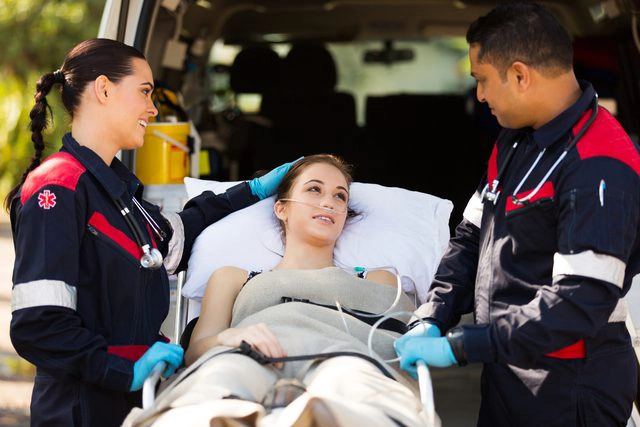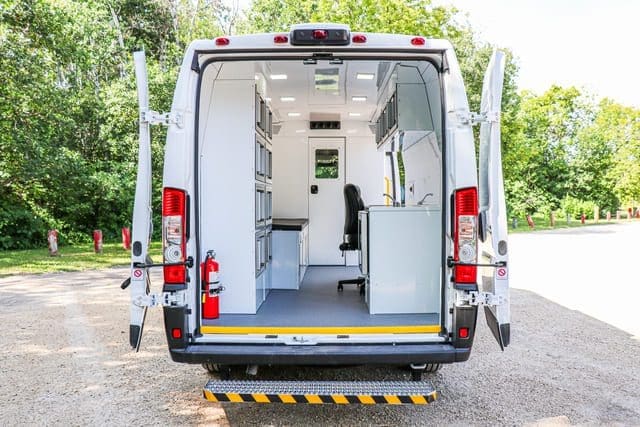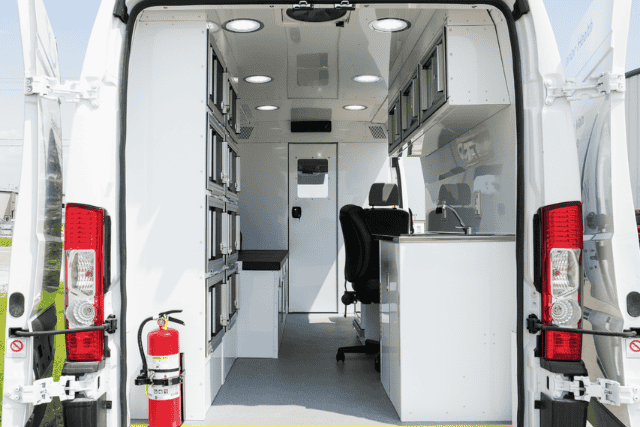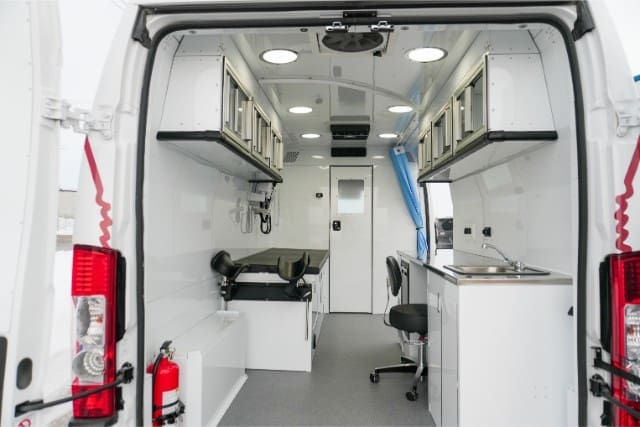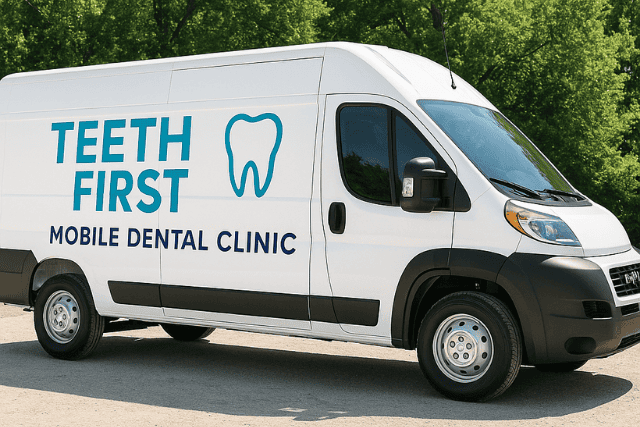Over 12% of adults in the U.S. have a disability that impairs them to the point that they can’t walk or climb stairs. Without proper gurney transportation, people in this group may experience delayed medical care, unsafe transportation, and unequal access to specialized services. A lack of gurney transportation also strains patient caregivers. Additionally, it adds to their workload and can lead to increased stress.
Our team at AVAN Mobility doesn’t like to see barriers getting in the way of people receiving healthcare. That’s a big reason why we’ve been manufacturing mobile medical vans for over 10 years now. We manufacture these vans so organizations like yours and the Community Clinic of Southwest Missouri can use them to assist people in breaking barriers and getting the care they need and deserve.
Gurney transportation is one method that ensures patients don’t have to struggle with getting from point A to point B. You’ll frequently see gurneys being used in hospitals and during medical evacuations. After reading this article, you’ll have a better idea of what gurney transportation is, how it works, and also what type of vehicle works well for it.
If you have any questions before we start, click the button below for some guidance.
Gurney transportation: What exactly is it?
If your organization is wondering about gurney transportation, you’re in the right place. Let’s take a closer look at what gurney transportation is, how it works, and where it’s used. This is especially important if your organization is thinking about providing gurney transport services to patients.
What’s a gurney? A gurney is like a bed on wheels used during patient transport. It’s used to aid in transporting individuals with mobility issues, who may require lying flat during transportation or who need medical attention while in transit. Additionally, it plays a crucial role in ensuring their safety and comfort throughout the journey.
Key features of a gurney include:
- Wheeled mobility: Gurneys have wheels that make them easy to push around.
- Adjustable: They can be adjusted to fit different medical needs and positions.
- Safety: Gurneys are designed to make sure patients stay safe during transportation.
The other part of gurney transportation is the vehicle which transports the gurney from one location to another. When most people think of gurney transportation, the first image that often comes to mind is that of an ambulance. However, this traditional view is just the beginning. Stay tuned to the rest of this article where we’ll later highlight one of the best vehicles that can be used for gurney transportation.
How does gurney transportation work?
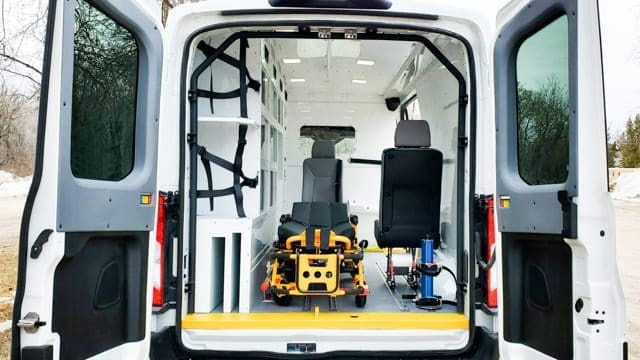
Now that you know more about gurney transportation, let’s take a closer look at how it works.
- Getting ready in the van
- Medical teams make sure the van is set up for safe patient transport.
- The gurney is secured in place to prevent any movement during the journey.
- Securing the patient
- Before the journey begins, patients are carefully placed on the gurney.
- Straps and restraints are used to keep the patient safe and comfortable during the ride.
- Smooth ride
- Vans equipped for gurney transportation have features like gentle suspension to ensure a smooth ride. These features help minimize bumps and vibrations to provide a more comfortable experience for the patient.
- The journey
- Drivers handle the van cautiously to ensure a smooth and steady journey.
- They might follow specific routes to avoid sudden stops or sharp turns.
- Arrival and transfer
- Upon reaching the destination, the gurney is carefully removed from the vehicle.
- Patients are transferred to the appropriate medical facility or target area with the same attention to safety as during the initial setup.
Where is gurney transportation used?
To help you better understand gurney transportation, it’s helpful to look at a few examples of what types of organizations use it.
Hospitals and medical centers
Big hospitals and medical centers use gurney transportation to move patients around, especially between different parts of the hospital.
Example: Think about a patient going from the emergency room to the X-ray department or from surgery to recovery. Gurneys are used for this.
Ambulance services
Ambulance teams use gurneys to transport patients from accidents or emergencies to the hospital.
Example: Picture someone injured in a car crash getting safely moved from the accident scene to an ambulance, and then to the hospital.
Nursing homes and care facilities
Long-term care facilities, such as nursing homes, rely on gurney transportation for medical appointments or in the event of urgent assistance. Additionally, it ensures timely access to medical care for residents when needed.
Example: Imagine a resident at a nursing home with mobility issues needing to go to a medical appointment at a hospital. Some patients can’t sit upright in wheelchairs, and gurney transportation helps in cases like this.
Airports and travel assistance
Airports might offer gurney transportation to help travelers with medical needs move from the terminal to their final location.
Example: Consider someone with a medical condition that affects their mobility. They need to get from the airport to a hospital. Gurney transportation at the airport assists them in getting safely to the hospital when they otherwise wouldn’t be able to.
Rehabilitation centers
Centers focused on helping people recover use gurney transportation to move patients within the facility or to other facilities or hospitals.
Example: Think about a patient in a rehabilitation center being moved from their room to another facility for therapy. The rehab team carefully places patients on a gurney and, after that, transports them to a gurney transport vehicle. This vehicle then efficiently brings them to the designated facility, ensuring a seamless transition from one stage to the next.
Specialty clinics
Clinics that specialize in certain medical fields, like bones or nerves, use gurney transportation for patient transfers.
Example: Someone needs specialized ACL surgery from an orthopedic surgeon. They are placed on a gurney and transported to a van that brings them to a specialized treatment center.
Home healthcare providers
Organizations offering medical care at home might use gurney transportation to move patients for different healthcare services.
Example: A home healthcare provider might bring a gurney to a patient’s home for safe and comfortable medical transportation to a hospital.
As you can see, gurney transportation is a flexible solution used by many different organizations to make sure patients are safely transported. By now, you might be wondering what types of vehicles can be used for gurney transportation. Learn more about that in the next section.
What types of vehicles can be used for gurney transportation?

When you need to move patients on gurneys, different vehicles can be used. As a result, this ensures the journey is safe and smooth. An ambulance is one of the most commonly used options for gurney transport.
Another option for gurney transportation is the Mobile Response Van. This van is equipped with features specifically designed to ensure that patients remain comfortable, safe, and secure during transport. Furthermore, these features are tailored to meet the unique needs of each individual, enhancing their transport experience significantly. Check out some of the standout features of this van in the table below.
| Key features | Description |
| Stretcher and attendant transport | Makes sure the journey is secure with an advanced stretcher and attendant transport system. |
| Customizable seating layout with AutoFloor | Lets you change the seating arrangement on the go, fitting the patient’s needs. |
| Removable attendant seats on wheels | Makes it easier to move patients, and medical staff can respond quickly. |
| Robust storage solutions | Strong cabinets and quick-access openings keep medical supplies organized in the van. |
| Medical-friendly finishes | Surfaces that are easy to clean keep things tidy. |
| Comprehensive medical equipment integration | Has space for first responder kits, first aid kits, AEDs, defibrillators, oxygen bottles, and more. |
| Power | Comes with regular outlets, light switches, 12V plugs, and a power control panel for reliable power. |
Aside from gurney transportation, many different types of organizations are already using our Mobile Response Van for non-emergency medical transportation and to help out people dealing with homelessness and substance abuse.
Another vehicle you can use for gurney transportation is the P4 3-in-1 van. Read our article on it to learn how it can provide ambulatory and gurney transportation, all under the roof of the same vehicle!

Exploring further with AVAN Mobility
You came to this article to learn more about the ins and outs of gurney transportation. By now, you have a better understanding of what it is and how it works.
Mobile medical vehicles have a positive impact on people all over the U.S. Read our article on how they save lives to learn more about that impact.
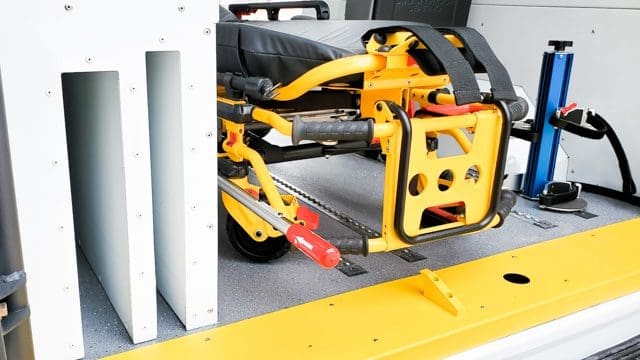
You should also read our article on how the Mobile Response Van compares to an ambulance. This might help you decide which vehicle could work better for gurney transportation.
See how the Mobile Response Van will support your healthcare or medical response efforts, click the button to talk to a mobility expert. They will answer any questions you have about other aspects of the mobile medical unit industry.
